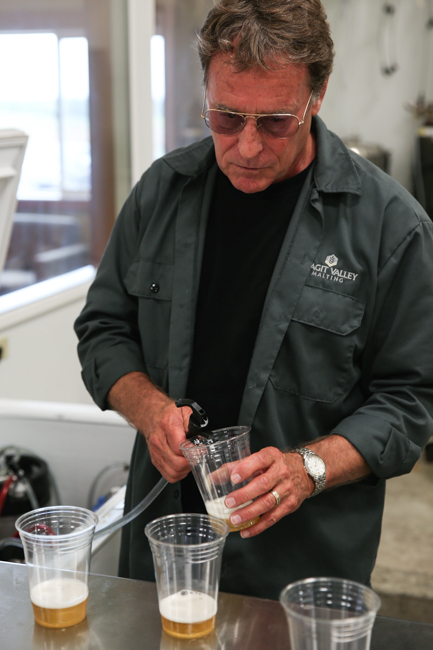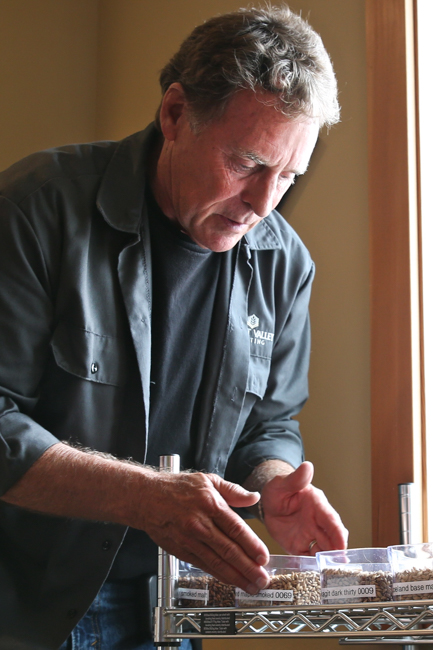In Search of Local Flavor

It’s hard to know exactly where to start when attempting to summarize what could be an eighteen page New Yorker length article into an easy-to-skim K&L blog post, so let’s just dive right into it. Here’s what I knew about the guys at Westland distillery going into my trip this week: they use local barley, local peat, and local oak to make a large percentage of their whiskey. They do so, however, because it actually makes their whiskey better, not simply because it’s fashionable in the food and drinks business currently. Of course they also enjoy supporting local farmers, making a product that’s regional and distinct, and working within the Seattle community to strengthen the ties of industry, but—unlike a number of exploitatively-local spirits—flavor is first and foremost on their minds. To better understand just how committed the gang at Westland is to creating a better tasting single malt, the two Matts (distiller Hofmann and sales manager Freerks) invited me to accompany them north of Seattle to the Skagit Valley, a fertile farmland known mostly for its tulips. They were vague on the details of our field trip, promising me that I would understand the significance of our appointment when I met our hosts. We were starting at the Mount Vernon outpost for Washington State University known as the Bread Lab where Dr. Stephen Jones was waiting for us.

Dr. Jones is a bit of a folk hero in the food world (read this related article in New York Magazine) and let’s just say he’s not very popular with Monsanto. He’s a professor and a breeder of wheat, barley, beans and various small grains and one day he decided he was tired of big agriculture telling him what did and didn’t constitute quality when it came to commodities. “The commodities market has no room for flavor,” he said with a chuckle as we stood in his barley breeding field outside the main office, “Once you start operating outside of it you’re free to focus on quality.” What large scale producers want in their wheat are characteristics that allow for high-speed, industrial baking that in turn allow for consistency and efficiency. Once all that starch is processed they add the flavor back in later with additives, chemicals, and other mystery ingredients (like caramel in your whisky). Fortunately for us, Dr. Jones wasn’t interested in breeding commercially-viable grains for Wonder Bread. He was interested, however, in breeding flavorful, unique, and interesting grains that would flourish in the Skagit Valley soil, giving chefs, bakers, maltsters, brewers, and distillers like Matt the chance to work with real terroir. Dr. Jones is dealing with tens of thousands of different species, many of which have a unique flavor and flourish in the nearby soils; none of which are of interest to operations like Miller or Anheuser-Busch.

Terroir in barley? I’ve heard of that idea before; the concept that unique strains of barley growing in distinct regions of the world may be just as important to a whiskey’s ultimate flavor as certain grapes are to the character of a wine. I’ve even tasted a few local barley whiskies from Springbank and Kilchoman, a Bere barley expression from Bruichladdich, and an experimental barely release from Glenmorangie. They were indeed unique, but how thought out were they in origin? Why did the distilleries choose those particular strains? Did they taste better? Were they more interesting? Or was it simply a fun little exercise in locavore politics? Perhaps it made for a better story than it did a whisky. It’s tough to know how important the inherent flavor of barley to whisky is when you have no real point of reference. As we walked through the barley rows, each with its own individual strain, I noticed the difference in breeds—the various colors, the different shapes and sizes. “Barley has historically been grown in the region as a way to replenish the soil,” Matt Hofmann said to me. “The farmers would then try to sell it off as feed and maybe break even before replanting their more profitable crops.”
“What we need to do is find a way to make it profitable for them,” said a voice from behind me.
A man in aviator sunglasses was approaching the field, looking a bit like Lou Reed from a distance. It was Wayne Carpenter, the founder and director of Skagit Valley Malting—a company created roughly five years ago to begin malting some of Dr. Jones’s difficult local grains for commercial operations like Westland. “The Skagit Valley is a unique climate,” Wayne said to me after we shook hands. “There are only six others like it in the world and the barley that grows here is higher in starch and lower in protein, which is exactly what you want if you’re a brewer or a distiller. The problem is the kernels themselves are fatter and more difficult to malt.”
“That’s where you come in?” I asked with a smile. Wayne grinned.

Just up the road from the Bread Lab is the Skagit Valley Malting facility where Wayne has set up what could be the greatest malting production ever created. In fact, when Matt and Matt first visited the site and saw the machines up close, Wayne forced them to sign a non-disclosure agreement because he was still patenting the technology. Wayne is an interesting guy, a former military fighter pilot who was very successful as a computer engineer and mathematician during Silicon Valley’s processing boom of the early nineties. “We’re using technology to malt more efficiently. We’re not going backward,” he said to me as we walked into his lab. “Some people see what we’re doing here and they write it off because it’s modern, but we’re keeping the important elements in place.” I made a joke about Amish hipsters and we all laughed. In the food and drinks business the branding of “hand-crafted” has become a bit ridiculous, especially when much of what’s said to be “hand-crafted” isn’t all that good. At Skagit Valley Malting they’re incredibly focused on efficient and effective processing, it’s just that Wayne is doing so in the name of flavor, rather than at the expense of it. What’s even more compelling is that he’s invested more than ten million dollars in order to do so, all of it from his own fortune.

“Barley does not want to be made into beer or whiskey,” Wayne said as we moved over to his on-site testing brewery; “What it wants to do is make other little barleys, so it’s up to us to convert the starch into sugar before it tries to sprout.” Some strains of barley are more difficult to malt than others, which is why they’ve been phased out by the agriculture industry; they’re too difficult to work with on a large scale. But it just so happens that many of those difficult strains are the most flavorful when malted properly. Like I mentioned before, I’ve only tasted a few barley-specific whiskies in my lifetime. Part of the reason more distillers don’t experiment with various strains of barley is because they don’t know exactly what the resulting whisky will taste like. When you’re talking about years of maturation time, waiting around to see test the results isn’t exactly the most attractive business model. That’s why Wayne uses beer for flavor analysis rather than whiskey. Making multiple batches of identically-malted brews, each with the exact same amount of hops and yeast allows for a more realistic side-by-side comparison. “These are called ‘smash’ beers,” he told us; “Single Malt And Single Hops recipes. Everything is exactly the same except for the type of barley used.” All five were unique, and one in particular—a beer made with locally-grown Skagit barley—was simply to die for. It was indeed more flavorful and more delicious, and it did indeed make a better beer—just like he had pointed out back in the field.

While Wayne hasn’t done much in the way of marketing, the word is out in the food community about the various flours he’s been able to mill from his flavorful homegrown malting. The bakers from San Francisco’s legendary Tartine were scheduled to visit this week, and Wayne has similar appointments with Dan Barber and the team from Blue Hill in Manhattan. They’re apparently thrilled with the breads they’ve been able to make from his collaborative work with Dr. Jones and there’s even been talk of specific tasting menus. Can you imagine it? Barley-specific bread paired with beer and whiskey made from the same strain? The possibilities are endless. What struck me most of all was something Wayne said before we left: “Silicon Valley helped make Napa what it is today. Without heavy investment and a market for those wines it could have become another Danville.” Wayne thinks the Skagit Valley could do for barley what cabernet did for St. Helena. Can you imagine that as well? A Napa Valley-like home for craft beer and whiskey just outside of Seattle? Wayne isn’t just imagining it, he’s banking on it—literally. From what he told us, there are already a number of big craft beer names looking into property just across from his malting center. Even I was practically itching to buy a plot of land nearby after he finished talking. I meet Bay Area tourists every day who plan on spending a few days in wine country. Why wouldn’t a veritable beer country have the same appeal in the Pacific Northwest?

“This is the local eco-system we’re talking about when we talk about Westland being a locally-made whiskey,” Matt said to me as we drove back towards Seattle that evening. I was flat out inspired. This is the model all locavores should be working towards. You’ve got local farmers sitting on some of the best barley terroir in the world, but they can’t grow it profitably without customers. With the help of Dr. Jones, Wayne Carpenter, and Westland, however, they just might create an entirely new economy for it—one where everyone wins. The farmers get paid, Wayne gets paid, Westland gets a better barley, and the customer gets a better beer or whiskey, all while working to be sustainable and improving the local agriculture. Isn’t that everything working and buying locally should be about? It gets better, actually. Apparently not only is Wayne’s malting technology better at malting the Skagit Valley barley, it only uses a fraction of the energy and water used by standard malting facilities. “It’s green as well?” I asked him with amazement.
“Yeah, but I was really just trying to save money,” he said in all seriousness; “I came into this as a problem solver, mainly.” Barley that’s more flavorful and cost-effective? I have to imagine it’s only a matter of time before Skagit Valley seriously revolutionizes the way we think about whiskey. Once again, Westland is leading the way. It was never just about making single malt in Seattle for these guys; it was about making single malt in an environment that is uniquely and geographically suited for doing so. The proof of that is in the pudding. It’s in the soils of the Skagit Valley as well.
-David Driscoll
